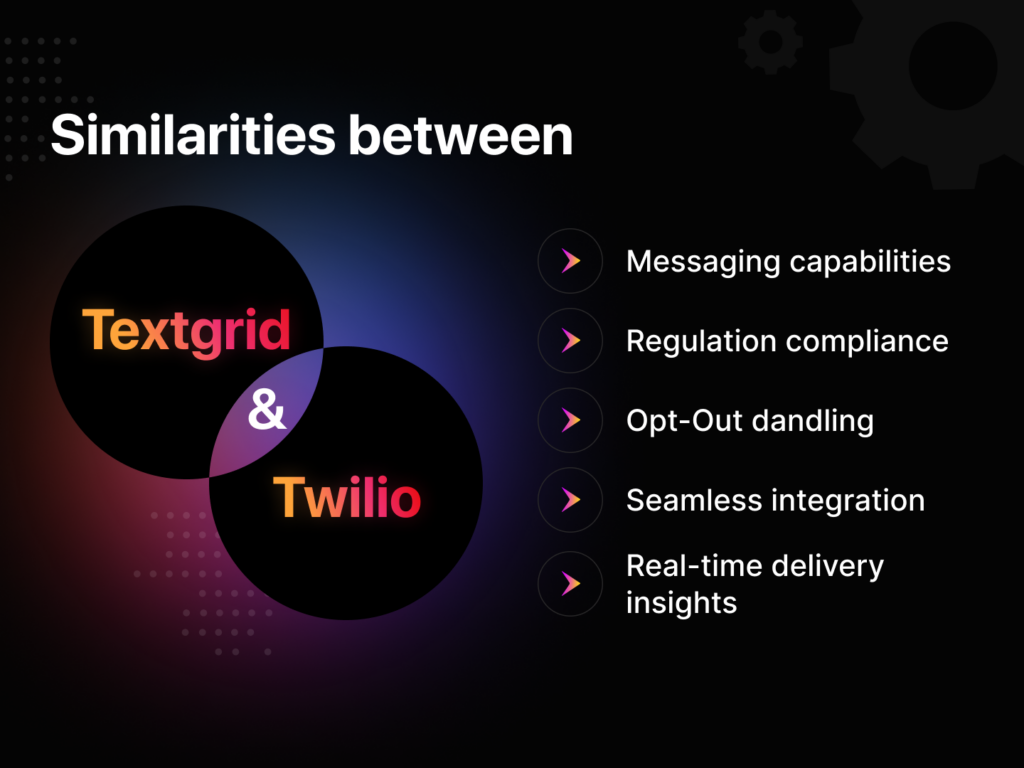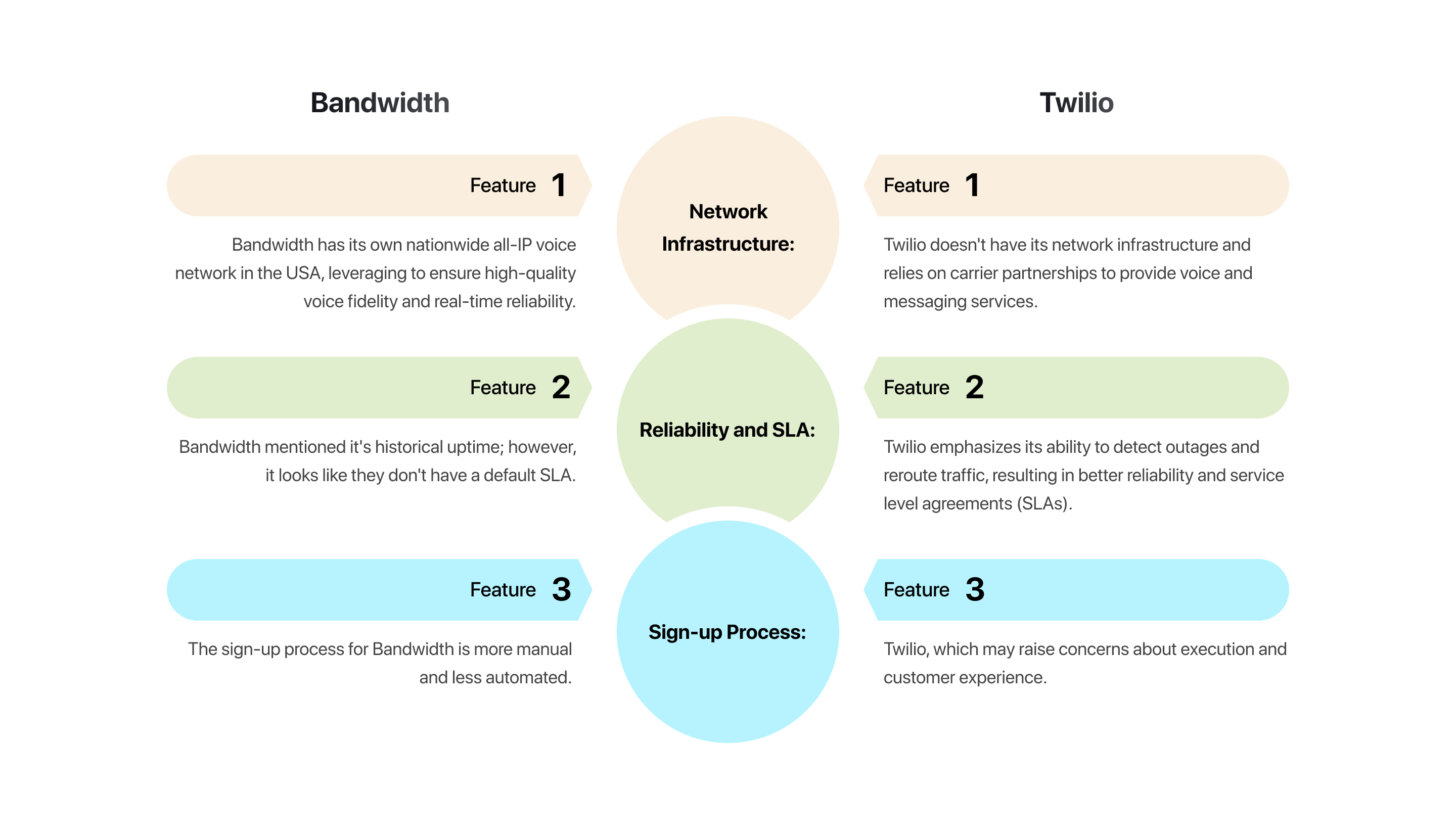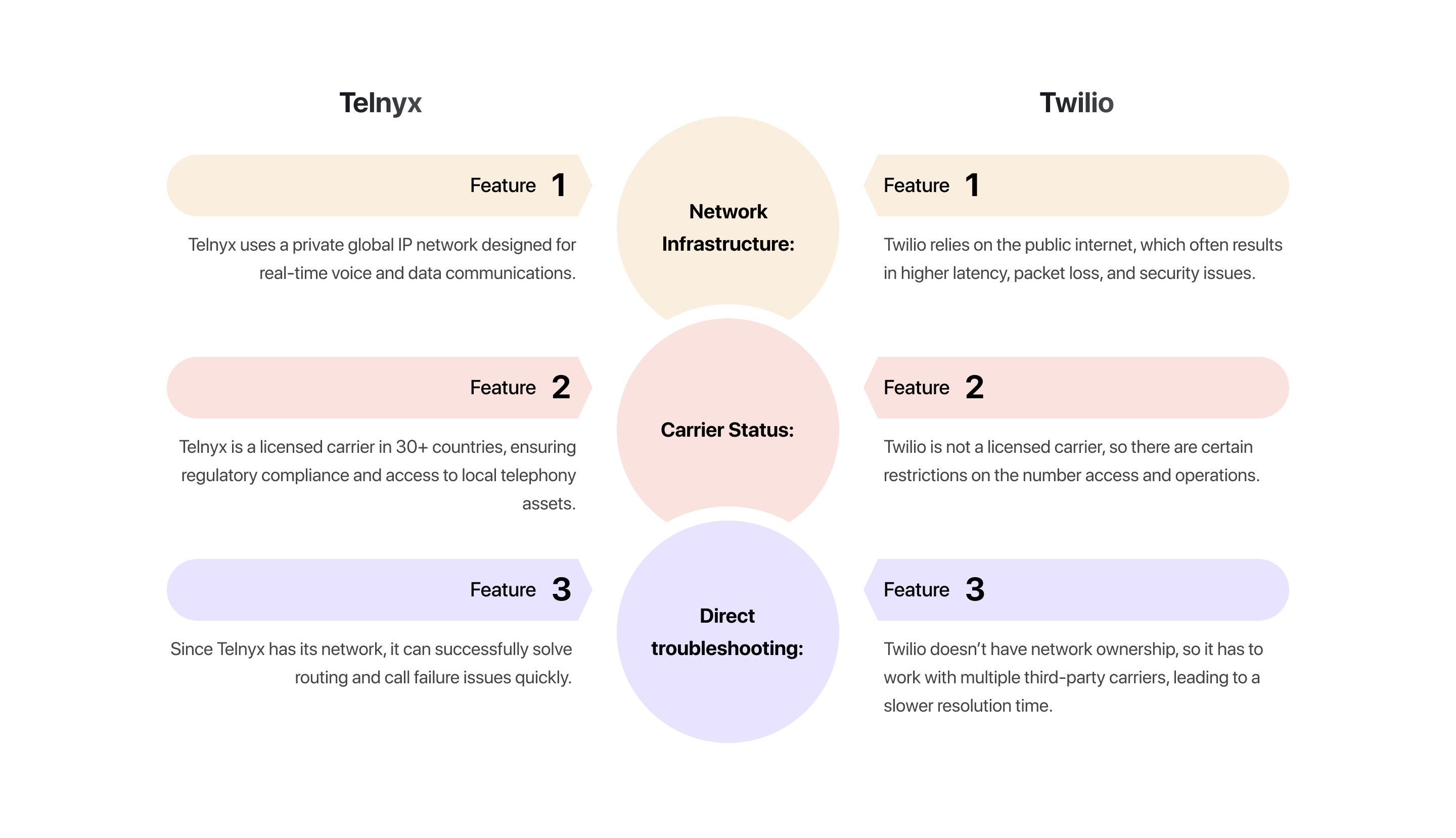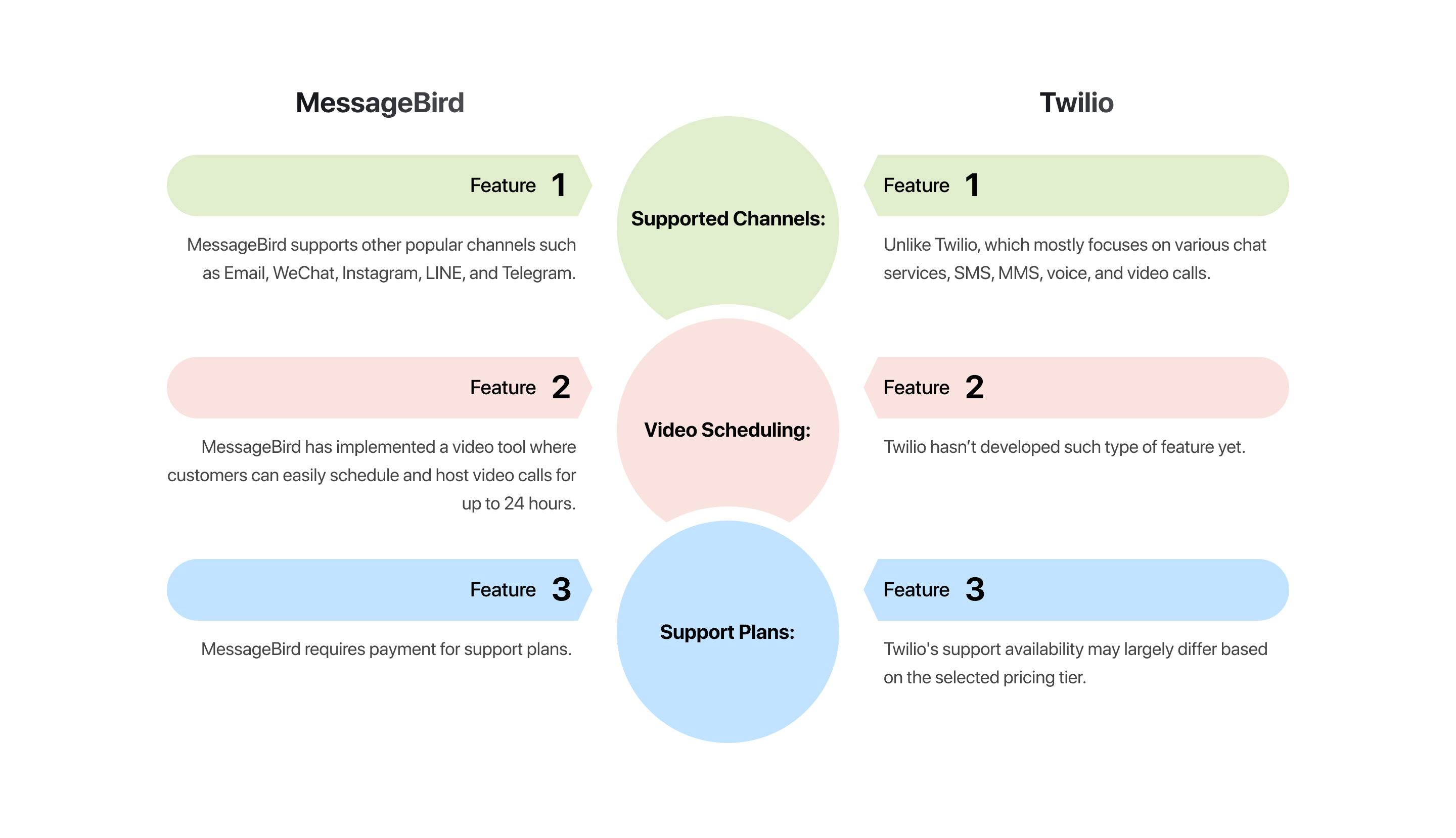Exploring the best Plivo Alternatives?
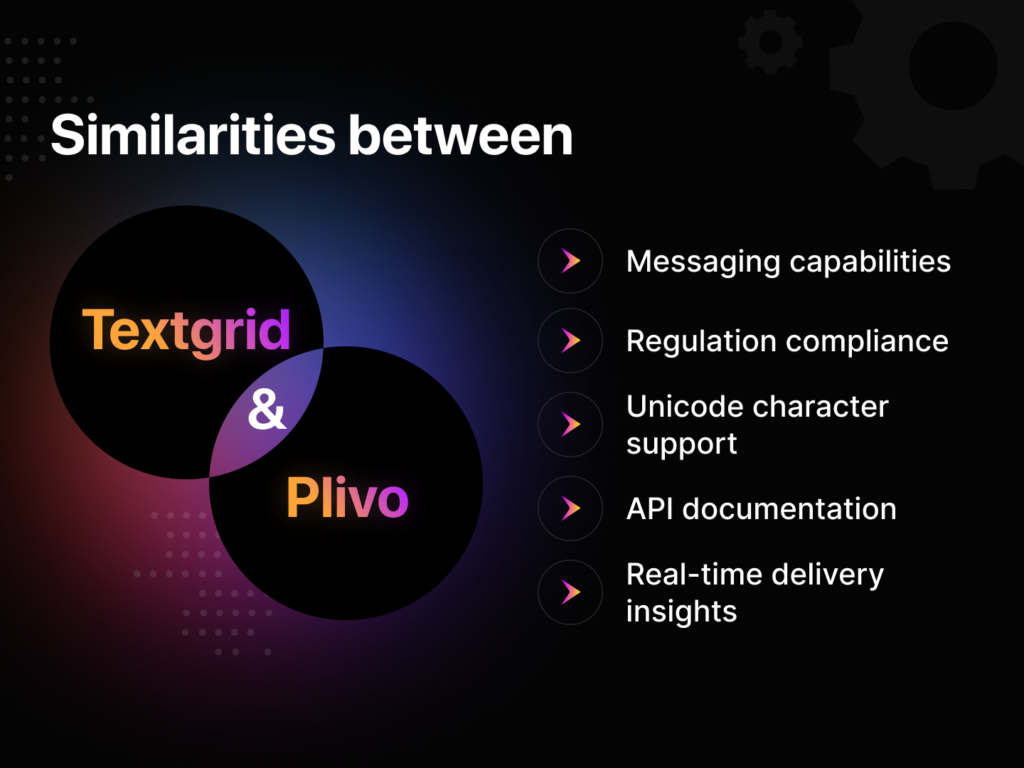
Stick to find out more.
What is Plivo?
Plivo’s story began in 2011 when co-founders Mike and Venky met by chance on Github and began discussing their shared need for a reliable communication platform with Voice and SMS capabilities for web-based applications.
They were struggling to find a solution that could satisfy their requirements, so they decided to create their platform, which evolved into introducing the cloud platform, Plivo.
Plivo currently offers RESTful Voice APIs, SMS APIs, Local Phone Numbers, and SIP Trunking, helping businesses of all sizes to integrate communication features into their web, browser, or mobile apps.
Plivo is strongly dedicated to revolutionizing the world of telecommunications by offering a straightforward and reliable infrastructure solution as its main objective.
From managing carriers to ensuring call quality and message delivery and offering round-the-clock technical emergency support, Plivo handles all the essential aspects, allowing businesses to concentrate on their core competencies.
Plivo Alternatives: Pricing, Features, Pros and Cons
- The recent rise of the Communication Platform as a Service (CPaaS) market has led to an abundance of competitors offering substantial discounts on voice and SMS services.
- However, cost reductions frequently come at the sacrifice of quality. It is absolutely imperative to closely evaluate all market options while centering your focus on the SMS-enabled numbers.
- While looking for alternatives to Plivo, the main focus should be on finding a platform that can supply a significant portion of your target numbers list and can help streamline operations by eliminating the need to engage multiple suppliers.
- While Plivo diligently optimizes its infrastructure in all aspects, including carrier relations and network architecture, to deliver clients an exceptional communication platform at an affordable price, some limits remain, forcing some customers to seek alternative options.
- If you are having difficulty understanding Plivo’s documentation and organizational structure, dealing with the complexities of its features, or encountering limitations regarding support options, community forums, or service reliability, we recommend considering alternative companies similar to Plivo.
TextGrid vs Plivo
TextGrid is currently redefining API messaging by offering developers an innovative service with features comparable to Twilio, making it one of the most convenient Plivo SMS competitors. Also, another advantage worth mentioning is its low price, which makes it an especially favorable option for new businesses.
Additionally, while transitioning from Twilio to TextGrid’s platform, TextGrid ensures a smooth transfer with no disruptions.
TextGrid vs Plivo – How do they compare?
Differences
- Long Messages:
TextGrid allows you to send long messages without being limited to the standard 160-character limit, while Plivo still sticks to the traditional limit. - Global Messaging:
TextGrid has coverage in over 190 countries, while Plivo’s global messaging capabilities support delivering SMS to all countries and providing local numbers in 55 countries. - Storage Environment:
TextGrid and Plivo both provide HIPAA-compliant storage environments. However, TextGrid uses Microsoft Azure to store data, while Plivo uses Amazon Web Services (AWS) and operates under a shared security responsibility model. - Opt-out Management:
While Plivo focuses on specific keywords in inbound messages to block outbound communications, TextGrid relies on the user text-specific terms as the message’s sole content. TextGrid also provides message content instructions and a confirmation message following opt-out. - Integration and Migration:
While Plivo’s integration requirements are a bit more complex and demanding, TextGrid emphasizes seamless migration with existing systems, allowing businesses to switch platforms with minimal changes. - Voice and Video Communication:
Plivo offers APIs for building and managing voice and video communication systems, while TextGrid focuses primarily on messaging.
Similarities
- Messaging Capabilities
TextGrid and Plivo platforms offer businesses innovative features to stay in touch with their customers via SMS, MMS, and other media. - Regulation Compliance:
Both platforms follow international regulations to protect user privacy and data. TextGrid follows carrier regulations, whereas Plivo complies with HIPAA, PCI DSS, SOC2, GDPR, and CPA standards. - Unicode Character Support:
Both platforms support Unicode character formats, enabling effective communication with customers from diverse linguistic backgrounds. - API Documentation:
TextGrid and Plivo provide API documentation, including sample codes and server-side SDKs, to help developers implement their services. - Queuing and Prioritization:
TextGrid and Plivo feature structured queuing and prioritize message delivery based on defined regulations. - Real-time Delivery Insights:
TextGrid and Plivo offer real-time delivery insights, allowing businesses to monitor and troubleshoot message delivery and engagement.
TextGrid vs Plivo – Pricing comparison
TextGrid Pricing
Outgoing
Incoming
$0.0035
Free
$0.01
$0.01/msg
$0.0064/min
$0.004/min
Plivo Pricing
Outgoing
Incoming
$0.0050/msg
Free
$0.016/msg
$0.0080/msg
$0.0100/min
$0.0055/min
Carrier Lookup Pricing
Phone Numbers
Email API
$3/mo
$0.1/month/phone number
$0.00063/email $32/mo.
Flat rate. No minimums. No overages
$0.004 per request
$0.004 per request
Don’t offer email API
Textgrid Pricing
Outgoing
Incoming
SMS API
$0.0035
/msg
Free
MMS API
$0.01
/msg
$0.01
/msg
Voice API
$0.0064
/min
$0.004
/min
Plivo Pricing
Outgoing
Incoming
SMS API
$0.0050
/msg
Free
MMS API
$0.016
/msg
$0.0080
/msg
Voice API
$0.0100
/min
$0.0055
/min
Textgrid Pricing
Carrier Lookup Pricing
$3/mo
Phone Numbers
$0.1/month/ phone number
Email API
$0.00063/email $32/mo.
Flat rate. No minimums. No overages
Plivo Pricing
Carrier Lookup Pricing
$0.004/request
Phone Numbers
$0.004/request
Email API
Don’t offer email API
Twilio vs Plivo
Twilio’s strategy has inspired several APIs and vendors to use their technologies and integrations. Eventually, these rivals will most likely outperform the original competition, and one of them is Plivo, another popular choice for many businesses.
Many customers consider Plivo an excellent alternative to Twilio because of its more affordable pricing and ease of integration. Twilio is a complicated pattern for business developers that requires particular developer knowledge.
In contrast to Twilio, Plivo gives comprehensive delivery reports. However, Plivo’s compatibility heavily depends on the specific qualities you prioritize.
Twilio vs Plivo – How do they compare?
Differences
- Shortcodes:
Twilio allows you to send and receive 100 messages per second (MPS) by default in the United States, Canada, and the United Kingdom, up from 30 MPS.
Plivo only mentioned that they offer high volumes of SMS and MMS messages. - Flow Builders:
The Plivo High-Level Objects editor allows the creation of communication flows.
Twilio features a similar interface for creating communication flows called Twilio Studio which outperforms Plivo High-Level Objects by offering customers much larger customization preferences and advanced widgets and trigger capabilities. - Analytics and Reporting:
Plivo’s console includes SMS and MMS logs where users can easily access message-related information.
Conversely, Twilio offers Messaging Insights, a real-time dashboard that delivers detailed reports on messaging activities. This tool shows up-to-date analytics and insights, improving the message campaigns. - Developer Support Tools:
Both platforms have developer support tools enabling users to implement and use their features efficiently. Plivo supplies developers with API documentation, sample code, and server-side SDKs.
Similarly, Twilio has API documentation, code snippets, tutorials, and web/mobile SDKs. - Message Personalization and Flexibility:
Plivo supports both GSM and Unicode character formats, allowing users to send and receive messages in various languages and character sets. Twilio’s APIs, on the other hand, go beyond character formats to enable extra functionality such as message scheduling, using the conversations API and adding rich text into messages. This increased flexibility, allowing users to personalize their messaging experiences. - Data Security and Privacy:
Plivo complies with worldwide regulatory standards such as HIPAA, PCI DSS, SOC2, GDPR, and CPA. This thorough compliance framework assures the security of sensitive data and users’ privacy.
Twilio offers features like message redaction and advanced customization options for opt-out and opt-in processes that improve data privacy and a more personalized approach. - Developer Resources:
Both platforms provide comprehensive guides and tutorials to assist developers in properly integrating their services. However, Twilio’s popularity and widespread use have resulted in a larger and more active developer community than Plivo, resulting in a much wider variety of resources for developers.
Similarities
- Messaging Capabilities:
Plivo and Twilio offer APIs allowing businesses and developers to integrate voice, SMS, and other communication features into their online or mobile applications. - Voice Communication:
Both platforms have voice communication options that feature making calls to different countries and buying local numbers. - Call Recording and Monitoring:
Both platforms have call recording and monitoring features, allowing businesses to keep track of conversations and analyze call activity. - Contact Management:
Contact management services are available on both platforms, enabling businesses to manage customer or user information.
Twilio vs Plivo – Pricing comparison
Twilio Pricing
Outgoing
Incoming
$0.0075/msg
Free
$0.020/msg
$0.0100/msg
$0.0140 / min; $0.0140 /
min$0.0040 / min
$0.0085 / min; $0.0220 /
min $0.0040 / min
Plivo Pricing
Outgoing
Incoming
$0.0050/msg
Free
$0.016/msg
$0.0080/msg
$0.0100/min
$0.0055/min
Carrier Lookup Pricing
Phone Numbers
Email API
Formatting and validation – free per request
Inbound caller identification
$0.01 per request
Free feature
$19.95/mo* $89.95/mo*
Custom pricing for Premier Plan
$0.004 per request
$0.004 per request
Doesn’t offer email API
Twilio Pricing
Outgoing
Incoming
SMS API
$0.0075
/msg
Free
MMS API
$0.020
/msg
$0.0100
/msg
Voice API
$0.0140/min
$0.0140/min
$0.0040/min
$0.0085/min
$0.0220/min
$0.0040/min
Plivo Pricing
Outgoing
Incoming
SMS API
$0.0050
/msg
Free
MMS API
$0.016
/msg
$0.0080
/msg
Voice API
$0.0100
/min
$0.0055
/min
Twilio Pricing
Carrier Lookup Pricing
Formatting and validation – free per request
Inbound caller identification
$0.01 per request
Phone Numbers
Free feature
Email API
$19.95/mo* $89.95/mo*
Custom pricing for Premier Plan
Plivo Pricing
Carrier Lookup Pricing
$0.004/request
Phone Numbers
$0.004/request
Email API
Don’t offer email API
Bandwidth vs Plivo
Another Plivo like service that many businesses opt for is Bandwidth mainly due to its integration with a nationwide carrier network and it’s ultimately not a very demanding integration process.
Besides API management, Bandwidth is a versatile solution featuring constant updates and development in both phone and VoIP services.
By cutting out the middleman, they can provide competitive pricing and potentially much more affordable solutions as a cheaper alternative to Plivo.
Bandwidth vs Plivo – How do they compare?
Differences
- Network Infrastructure:
Bandwidth has its voice network and controls the telephony infrastructure, giving them greater control over call quality and dependability.
Plivo manages its infrastructure, which includes global carrier partnerships and network infrastructure, whereas Bandwidth owns and operates its nationwide IP voice network. - Phone Numbers Managing and Provision:
Bandwidth offers direct access to telephone numbers in the United States and Canada, allowing users to provision and manage phone numbers directly using their API.
Plivo, on the other hand, works with other service providers to give global number coverage. - Custom Pricing Models:
Bandwidth has multiple price models, including custom pricing and dedicated resource options, giving customers more flexibility in choosing what meets their requirements.
Plivo offers a pay-as-you-go pricing plan, so customers will only be charged for what they have used. - Additional Services for Specific Needs:
Besides communication APIs, Bandwidth’s services include other features such as 911 Access, Business Texting, and Toll-Free Voice, which might be helpful for specific uses.
Plivo focuses mainly on communication APIs and does not offer any additional features.
Similarities
- Voice and Messaging APIs:
Bandwidth and Plivo offer voice and messaging APIs and support sending and receiving SMS messages, including multimedia content. - Flexible Integration:
Bandwidth and Plivo offer API integration options for applications and systems, allowing developers to incorporate communication features into their web or mobile apps easily. - Global Coverage:
Both services’ coverage extends across multiple countries and supports international communication. - Emergency API:
Bandwidth and Plivo provide an Emergency Calling API that enables steady connections to emergency services, giving organizations dependable access to public safety and first responders.
Bandwidth vs Plivo – Pricing comparison
Bandwidth Pricing
Outgoing
Incoming
$0.004 per message
Free
$0.015 per message
Free
$0.010 per min.
$0.0055 per min
Plivo Pricing
Outgoing
Incoming
$0.0050/msg
Free
$0.016/msg
$0.0080/msg
$0.0100/min
$0.0055/min
Carrier Lookup Pricing
Phone Numbers
$0.35 per request
$0.35 per number
$0.004 per request
$0.004 per request
Bandwidth Pricing
Outgoing
Incoming
SMS API
$0.004/
msg
Free
MMS API
$0.015/
msg
Free
Voice API
$0.010/
min
$0.0055/
min
Plivo Pricing
Outgoing
Incoming
SMS API
$0.0050
/msg
Free
MMS API
$0.016
/msg
$0.0080
/msg
Voice API
$0.0100
/min
$0.0055
/min
Bandwidth Pricing
Carrier Lookup Pricing
$0.35/
request
Phone Numbers
$0.35/
number
Plivo Pricing
Carrier Lookup Pricing
$0.004/request
Phone Numbers
$0.004/request
Telnyx vs Plivo
Telnyx is another leading company in the communication and messaging industry. It provides a user-friendly platform that allows customers to seamlessly transition to their services without compromising on any of the features that Plivo offers.
Telnyx’s versatility in managing private network environments is one of its most notable characteristics, giving its users complete control over call routing.
Also, it offers highly flexible pricing options according to the client’s specific requirements.
Overall, the Telnyx system is dependable, backed by technical support and additional resources to assist users in better understanding its capabilities. Here’s how it competes with Plivo.
Telnyx vs Plivo – How do they compare?
Differences
- Network Infrastructure:
Telnyx operates in a private network environment, which gives them complete control over call routing, ensuring efficient troubleshooting and quick and responses.
Plivo, on the other hand, relies on the public internet and intermediaries for call routing and essential communications functions, which can lead to delayed troubleshooting. - Number Selection Options:
Telnyx, as a linked VoIP carrier, has direct access to an extensive number database, providing better inventory control and flexibility.
Plivo relies on mediators to supply numbers, resulting in higher markups and fewer number selection options. - Pricing Flexibility:
Telnyx has the most affordable SMS price on the market. Receiving SMS is free while sending SMS is only $0.0025 per message, which is 50% less expensive than Plivo’s prices.
Plivo charges a higher fee of $0.005 for sending SMS, which can result in message scaling limitations due to increased costs. - Limited Support:
Telnyx provides developers with a self-service onboarding experience with live support. Developers will have immediate access to step-by-step guidance and on-demand support from the Telnyx engineers.
Plivo charges developers $49 monthly for guaranteed response times and extra costs for 24/7 assistance. Additionally, the customer assisting feature is available for a one-time fee of $1,500.
Similarities
- Messaging Capabilities:
Telnyx and Plivo offer cloud-based API systems for incorporating real-time communications into applications. They provide SMS services which allows users to send text messages to any phone number worldwide. - Voice and Video Communication:
Both platforms offer voice, video, and push notifications communication features if businesses explicitly look for a Plivo video alternative. - Global Coverage:
Both services’ coverage extends across multiple countries and supports international communication. - API Documentation:
Both platforms have exhaustive libraries with resources to assist users in navigating through their services. Both platforms’ fundamental user bases are mainly businesses and developers.
Telnyx vs Plivo – Pricing Comparison
Telnyx Pricing
Outgoing
Incoming
Starts at
$0.0075/ msg
Starts at $0.005/msg
Starts at $0.0085/min.
Starts at $0.0045/min
Plivo Pricing
Outgoing
Incoming
$0.0050/msg
Free
$0.016/msg
$0.0080/msg
Starts at $0.0100/min
$0.0055/min
Carrier Lookup Pricing
Phone Numbers
$0.003 per request
$0.002 per request
$0.004 per request
$0.004 per request
Telnyx Pricing
Outgoing
Incoming
SMS API
Starts at
$0.0075/
msg
Starts at/
$0.005/ msg
Voice API
Starts at
$0.0085/
min
Starts at
$0.0045/
min
Plivo Pricing
Outgoing
Incoming
SMS API
$0.0050
/msg
Free
MMS API
$0.016
/msg
$0.0080
/msg
Voice API
$0.0100
/min
$0.0055
/min
Telnyx Pricing
Carrier Lookup Pricing
$0.003/
request
Phone Numbers
$0.002/
request
Plivo Pricing
Carrier Lookup Pricing
$0.004/request
Phone Numbers
$0.004/request
MessageBird vs Plivo
MessageBird is a favorable alternative for all businesses that aim to make customer communication more manageable, modern, and simplistic. Unlike most competitors, they have their own telecom carrier infrastructure, which results in much smoother SMS, Voice, and Conversations API and fewer interruptions.
According to the company, their main goal is to make the interaction between businesses and their clients much more accessible and efficient. If you are looking to simplify and expand your communication with customers across multiple media channels, MessageBird could be a good alternative to Plivo sms.
Another advantage of MessageBird is its pay-as-you-go pricing plan, suitable for businesses with predetermined budgets looking for Plivo cheaper alternative.
Messagebird vs Plivo – Feature Comparison
Differences
- Customized Messaging:
MessageBird is primarily focused on SMS, voice API, and push notifications, and it presents a platform for businesses to reach out to their clients via customized messages.
Plivo offers multiple real-time communication services, including audio, video, SMS, and MMS push alerts. - User Interface:
MessageBird is known for its adaptable user interface, while Plivo is well-known for its fantastic UI/UX, being very visually appealing. - Multi-Channel Communication Options:
MessageBird supports SMS, voice, WhatsApp, RCS, Facebook Messenger, WeChat, Line, and more. Their unified API enables managing multiple channels at once which is more efficient for larger businesses.
While Plivo also supports SMS and voice calls globally, it offers a much more specific set of messaging channels than MessageBird.
Similarities
- Messaging Capabilities:
Both platforms cater to businesses who want to use SMS, Voice, and Conversations APIs for marketing, Customer service or notifications. - Integration Options:
MessageBird offers a diverse selection of integration options, including RESTful APIs, SDKs, and webhooks. They feature simple pre-built interfaces with well-known CRM systems like Salesforce and alternative platforms like Zapier and Zendesk.
Similarly, Plivo supports various integration options, including REST APIs, SDKs, and webhooks. They integrate with popular platforms such as Salesforce, Zendesk, HubSpot, and others. - Additional Support Documentation:
MessageBird supplies developers with tutorials and practical code samples, including email and chat support.
Plivo also offers these services, including phone support.
Messagebird vs Plivo – Pricing Comparison
MessageBird Pricing
Varies by country/volume
Starting at $0.0071/msg in US
Starts at $0.0033/min
Not Available
Plivo Pricing
Outgoing
Incoming
$0.0050/msg
Free
$0.016/msg
$0.0080/msg
Starts at $0.0100/min
$0.0055/min
Carrier Lookup Pricing
Phone Numbers
$0.011 per request
$0.011 per request
$0.004 per request
$0.004 per request
Messagebird Pricing
SMS API
Varies by country/volume
Starting at $0.0071/msg in US
MMS API
Starts at $0.0033/min
Voice API
Not Available
Plivo Pricing
Outgoing
Incoming
SMS API
$0.0050
/msg
Free
MMS API
$0.016
/msg
$0.0080
/msg
Voice API
$0.0100
/min
$0.0055
/min
Messagebird Pricing
Carrier Lookup Pricing
$0.011/request
Phone Numbers
$0.011/request
Plivo Pricing
Carrier Lookup Pricing
$0.004/request
Phone Numbers
$0.004/request
Plivo Competitors: How They Rank
Now that you have a general idea of how companies like Plivo compete against each other, here are the benefits you’ll get by choosing each platform as a Plivo chat alternative.
TextGrid
Twilio
Bandwidth
Telnyx
MessageBird
Best For:
- Long messages without character limits
- Best price for SMS API
- Coverage in over 190 countries
- Seamless integration and migration
- Allows sending and receiving 100 messages per second (MPS) by default in specific countries
- Supports extra functionality such as message scheduling and rich text.
- Has a large and active developer community
- Owns and operates a nationwide IP voice network
- Offers custom pricing options
- Includes additional services like 911 Access, Business Texting, and Toll-Free Voice
- Operates in a private network environment for efficient call routing
- Provides self-service onboarding with live support and immediate access to guidance from Telnyx engineers
- Offers an adaptable user interface
- Supports multiple communication channels, including SMS, voice, WhatsApp, RCS, Facebook Messenger, WeChat, Line, and more
TextGrid
Best For:
- Long messages without character limits
- Best price for SMS API
- Coverage in over 190 countries
- Seamless integration and migration
Twilio
Best For:
- Allows sending and receiving 100 messages per second (MPS) by default in specific countries
- Supports extra functionality such as message scheduling and rich text.
- Has a large and active developer community
Bandwidth
Best For:
- Owns and operates a nationwide IP voice network
- Offers custom pricing options
- Includes additional services like 911 Access, Business Texting, and Toll-Free Voice
Telnyx
Best For:
- Operates in a private network environment for efficient call routing
- Provides self-service onboarding with live support and immediate access to guidance from Telnyx engineers
MessageBird
Best For:
- Offers an adaptable user interface
- Supports multiple communication channels, including SMS, voice, WhatsApp, RCS, Facebook Messenger, WeChat, Line, and more


![Plivo Alternatives: The Complete List [2024]](https://textgrid.com/wp-content/uploads/2023/09/Banner_6.png)
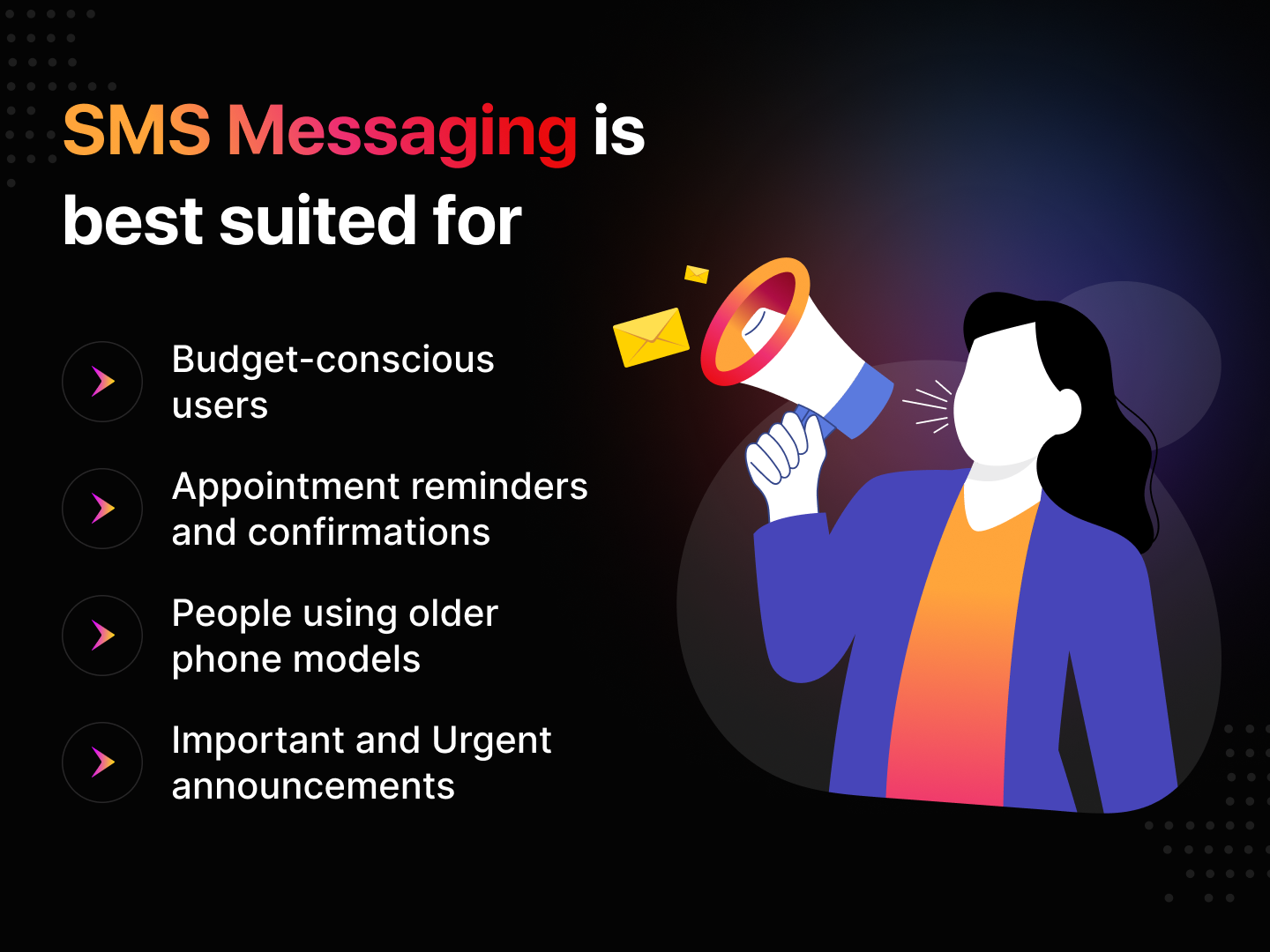
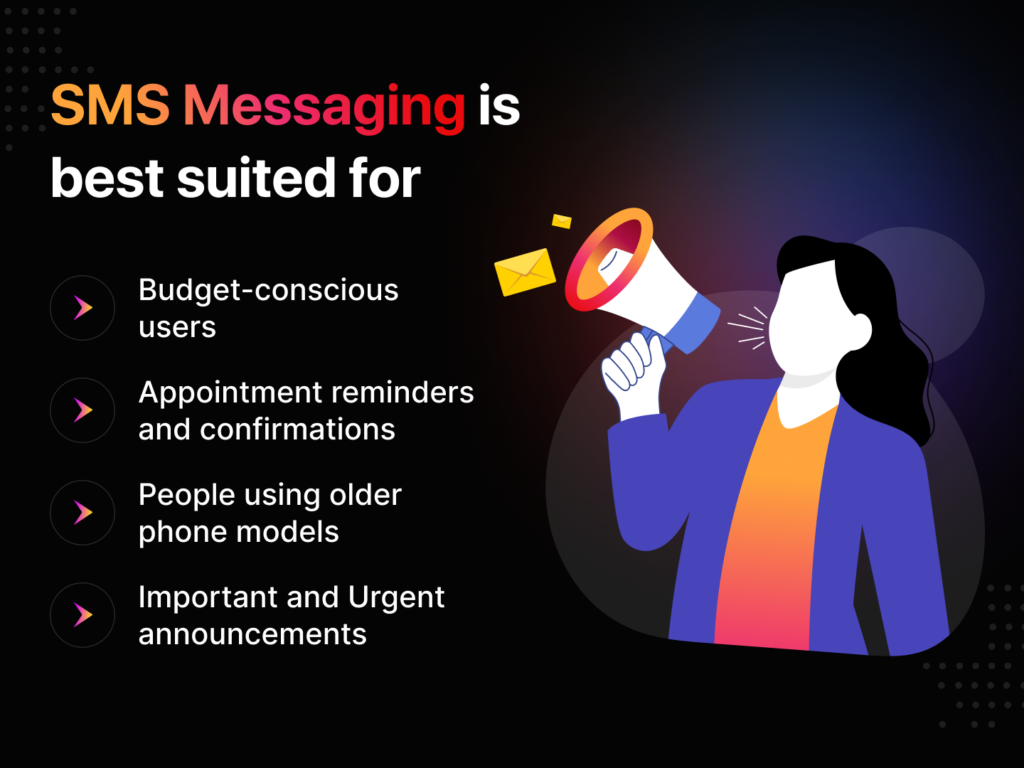






![Twilio Alternatives: The Complete List [2024]](https://textgrid.com/wp-content/uploads/2023/09/Banner_7.png)
